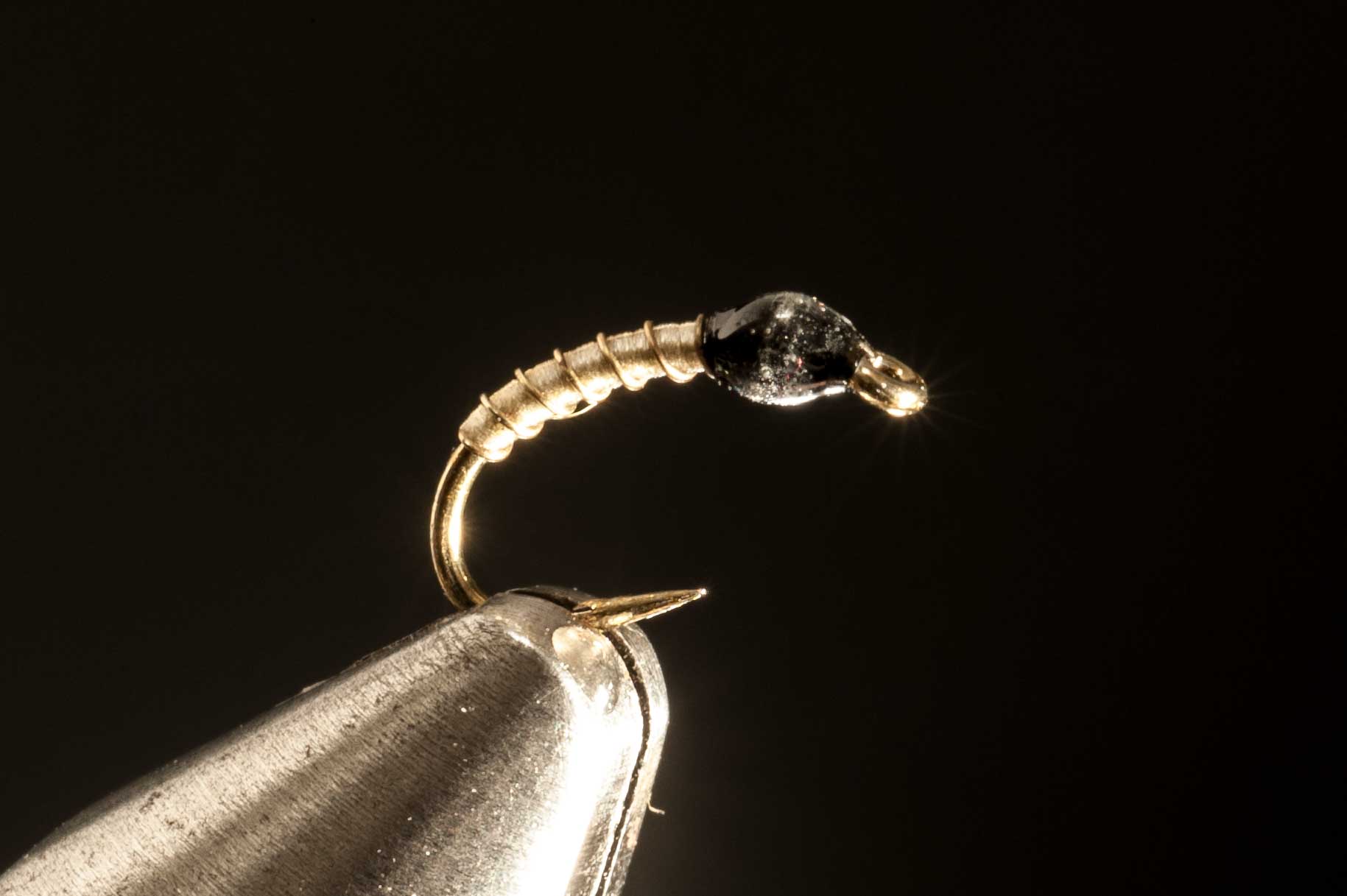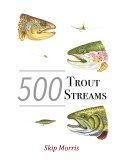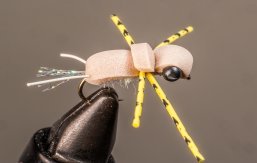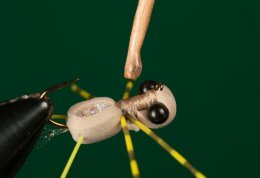Third Thursday Flies
9. Miracle Midge
with Skip Morris
The first time you see a catalog page of midge larva/pupa patterns, the first thing you'll notice is that these flies all look a lot alike. Each has a slim untapered body, a fine rib (though some lack a rib), a bulging thorax (of built-up thread or dubbing or suggested by a metal or glass bead). What you cannot see on the page but will see if you're looking at a bunch of midge flies in someone's fly box or in fly shop bins is that they're always very small to downright damned tiny. Dinky size 18 is about the upper limit, and though few fly fishers go below size 24, the lower limit is really determined by how tiny the manufacturers are willing to make hooks—there are 32s out there!
Midge flies are diminutive because the midges they imitate are equally so. (But that only goes for midges in moving water; for some reason they can be much larger in the standing water of lakes and ponds, where fly fishers call them "chironomids.")
One midge pattern I've successfully fished is the black-of-thorax, cream- or white-bodied (and that's about all I can say about it for certain) Miracle Midge.
Two decades ago, Carol and I spent a month in a very old refurbished cabin at a very old commercial train stop turned resort, old enough that the tracks were long gone, high in the Colorado Rockies. In the fly shop in a nearby scattering of homes and a very few businesses barely qualifying as a town, Carol and I got instruction on tying the fly. The young salesman held one up to a fluorescent light, peering at it himself under his blond curls, and said, "Keeping the floss body thin is tricky, so use just a few fibers." (I decided, right then, to instead build the abdomen using thread.) And, "The rib can be gold or silver or copper wire." He was vague, too, about the thorax: "Just some black thread or dubbing." Vague, but it was enough.
It was enough that I tied some up in size 20 through 24 or 26. And enough that they got me into trout. The only trout among them I remember in particular was one I never saw.
I knew the fly, lacking a metal or even a glass bead, was too lightweight to sink much on its own—unless the trout were positioned high in the current, picking off midge pupae only inches down, the fly would need help. I could have used a larger, heavier nymph to drag down the Miracle Midge but went for a dinky split shot instead. There still wasn't much weight there, but it was sufficient for the soft flow.
The trout were persnickety as hell. They had everything working for them: stunningly clear water, gentle currents, scads of food, the smarts that go with being browns and rainbows, and enough fly piercings to have fully grasped the lessons anglers and their flies had been teaching. Those lessons amounted to: Here are the signs, don't get pierced again. I had fine tippet, positions chosen for clean fly drifts and stealth, split shot to get me down to where the trout held, and a fly-box corner crowded with Miracle Midges. In practice, it was close to a standoff.
But repeated standoffs fall one way, then the other, and so I caught trout by careful persistence. That big boy, though: I never came close to catching him.
He sure hated it when I hooked him, though. My orange dot of strike indicator quivered, I set, the trout paused in disbelief—and then he was off. The line rushed out the rod-tip. I pressured him, but that was useless. There's some tiny relief in knowing you didn't exactly lose a big fish but that he got off by chance (the hook came free), yet it's only a pinch of consolation in a cauldron of churning heartache.
Still, as the old chestnut almost goes: 'Tis better to have hooked and lost than never to have . . .
Much later, I found the pattern in Takahashi and Hubka's Modern Midges, and though the authors credit the originators of nearly all the patterns, no name is given for the Miracle Midge. That's never good—from whom do you get and confirm the details, who has the final word? So I'll give you the dressing as it was given me since I know the fly works on wary trout when tied that way, no matter what rib or thorax you choose.
MIRACLE MIDGE
HOOK: Heavy or standard wire (light wire if you must—the tiniest fly hooks are mostly fine wire), short shank to standard length, humped scud/pupa hook (or a straight-shank hook), sizes 26 to 18.
THREAD: White or cream 8/0 or 6/0 for the body, black 8/0 for the thorax whether it's of dubbing or thread.
RIB: Fine gold or copper or silver wire.
THORAX: Black rabbit or built-up thread. (I like the thread and coat the thorax in head cement or UV coating or epoxy glue. Makes the fly tougher, yes, but mostly I do it just to please myself.)
Click here to hear Skip's interviews on popular podcasts...
*Announcements*
Skip has an essay in Big Sky Journal's annual Fly Fishing issue, called "Montana Hoppers: the Princess and the Brute" released February 1, 2023. Skip rewrote it a bit; I painted and illustrated it here, on our website. Here's the link on our web page to check it out:
Click here to read Skip's essay Montana Hoppers: The Princess and the Brute...
Skip's latest books:
Top 12 Dry Flies for Trout Streams: How, When, and Where to Fish Them, is now available on Amazon as an ebook...check it out! Click on the links below to go to the information page on Top 12 Dry Flies (the link to Amazon is at the bottom of the page...)
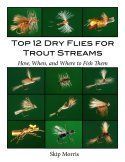 Top 12 Dry Flies for Trout Streams: How, When, and Where to Fish Them
Top 12 Dry Flies for Trout Streams: How, When, and Where to Fish Them
Click here to get more information about
Top 12 Dry Flies for Trout Streams: How, When, and Where to Fish Them (the link to Amazon is at the bottom of the page)...
Top 12 Dry Flies for Trout Streams: How, When, and Where to Fish Them (the link to Amazon is at the bottom of the page)...
Top 12 Nymphs for Trout Streams: How, When, and Where to Fish Them, 2nd Edition, originally published as an e-book only, is now available on Amazon as a paperback...check it out! Click on the links below to go to the information page on Top 12 Nymphs (the link to Amazon is at the bottom of the page...)
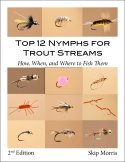 Top 12 Nymphs for Trout Streams: How, When, and Where to Fish Them (2nd Edition)
Top 12 Nymphs for Trout Streams: How, When, and Where to Fish Them (2nd Edition)
Click here to get more information about
Top 12 Nymphs for Trout Streams: How, When, and Where to Fish Them (2nd Edition). . .
Top 12 Nymphs for Trout Streams: How, When, and Where to Fish Them (2nd Edition). . .
Click here to get more information about Skip's e-book,
500 Trout Streams...
500 Trout Streams...
Skip's latest paperback book:
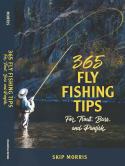 365 Fly Fishing Tips for Trout, Bass, and Panfish
365 Fly Fishing Tips for Trout, Bass, and Panfish
Click here to get more information about Skip's latest book,
365 Tips for Trout, Bass, and Panfish...
365 Tips for Trout, Bass, and Panfish...
Print Skip's chart for FREE:
Skip Morris's Trout-Fly Proportion Chart
Go to Skip Morris's Trout Fly Proportion Chart
Skip's Predator is available to buy...
Skip's ultra-popular Predator—a hit fly for bluegills and other panfishes and largemouth bass (also catches smallmouth bass and trout)—is being tied commercially by the Solitude Fly Company.
The Predator
CLICK HERE to learn more about or to purchase the Predator...
Learn to Tie Skip's Predator
Do you want to tie the Predator?
Tying the Predator
Skip shows you how to tie it on his YouTube Channel link, listed below:
CLICK HERE to see Skip's detailed video on how to tie the Predator...
